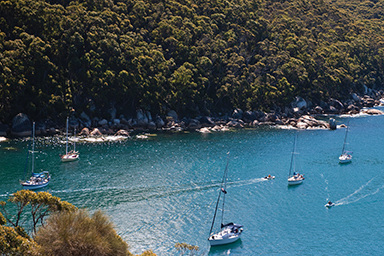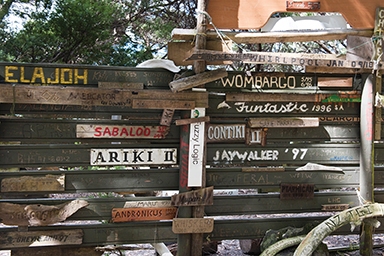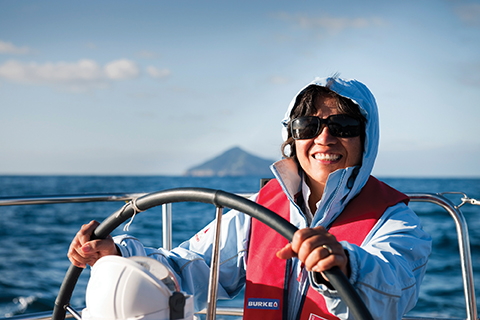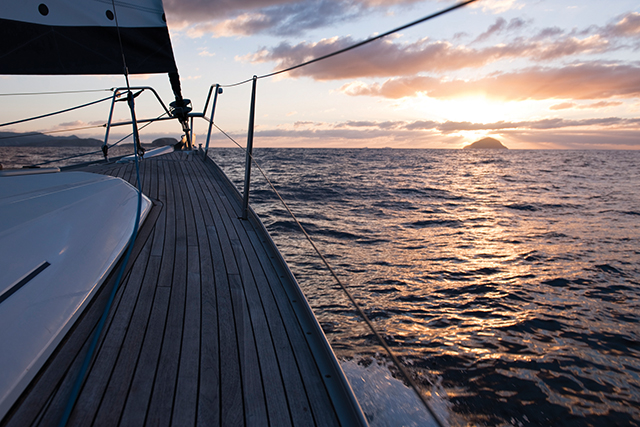A tale of two approaches to an enchanted Australian cove (published August 2012)
It is 140 nautical miles from my home port in Williamstown, at the mouth of Melbourne, Australia’s Yarra River, to the beautiful little bay known as Refuge Cove on the east side of Wilson’s Promontory. Refuge Cove, as the name implies, is a sheltered spot. The “Prom” is a magnificent national park covering both land and sea. For the last two (southern) summers it has been my cruising destination. This is the story of those trips; in some respects it is also the tale of how-to and how-not-to do it.
A TIME FOR WORK…
The route goes almost a little west of south the full length of Port Phillip Bay for around 30 nm, out the heads through the notorious Rip, then southeasterly past Cape Schanck, along the bottom of Phillip Island, then a long haul in the northern reaches of Bass Strait, through the islands that gaggle southwest of the Prom, past the tip which is the southernmost point on the Australian mainland, and round up at the lighthouse on South East point to work halfway up the east side of the Prom. Not an excessively difficult feat of navigation.
On board apart from the skipper were my friend Rod (an experienced former ship’s officer with tens of thousands of sea miles under his belt), my better half Minda, our 22-year-old daughter Paris, and her 26-year-old boyfriend Matt. The last three all had limited sailing experience.
In the summer of 2010, our Dufour 385GL Papalana was just six months old. Not all the autopilot teething troubles had been sorted out, or so we were to discover. The boat itself, however, was wonderful, performing flawlessly throughout both trips.
We were 40 minutes late departing that first morning, and immediately found ourselves with 20 knots on the nose, motoring into seas that were continuing to build. Port Phillip is shallow and infamous for short, sharp waves, plenty of which were coming our way that morning. An hour out, the autopilot gave up and stayed in hibernation for the rest of the trip.
The combination of the late departure and the adverse conditions resulted in us arriving at the heads more than an hour after the latest time we should have been there. The tide had turned to ebb. This might have been thought to be to our advantage, speeding us on our way out. In fact, it simply set up a wind versus tide scenario in one of the most dangerous entrances in the world.
I checked in with Point Lonsdale radio to get a shipping report and to advise them of our preferred channel. They will tell you if the Rip is closed, but when it is open it is not their job to advise individual skippers whether it is a good time to go or not. But they must have been wondering about the wisdom of going out just then, and I would have preferred they wondered aloud.
The heads at Port Phillip and the Rip is not unknown to me. I have been through it many times on others’ boats and dived there five or six times. It is one of the great temperate water SCUBA dives in the world. All that water rushing in and out provides conditions that marine animals love.
The wind had increased to just under 25 knots as we made our approach. As soon as we climbed up the first big wall and fell off the back, I knew we could not safely turn around. The flat foresection of Papalana’s modern-design hull hit the water with a crack that brought the crew below to the hatch with quizzical looks. I concentrated on the job at hand and on watching young Matt on the helm. Matt stayed solid, and the boat took the pounding of several similar drops before we came through. It was a long half hour.

…AND A TIME FOR PLAY
The rest of that trip was a relative breeze. A helpful, caressing 15-knot-on-the-beam breeze, in fact, that gradually lessened and faltered just before dawn. We were at the southern tip of the Prom by then, with a glorious morning light framing the islands. Mid-morning saw us anchored in Refuge with a tired but rightfully proud crew. They had done well, no exceptions.
There were half a dozen boats in Refuge at the time, all sailboats except for one large motor yacht. Strangely, its skipper, Barry, was easily the most experienced sailor in the cove at the time, coming from a famous sailing family that included Olympic champions. He was extremely helpful and generous to all of the sailors, providing everything from phone battery charging to water and even diesel. We forgave Barry for going over to the “dark side.”
It turned out that in his day job, Barry is a Port of Melbourne sea pilot, and the Rip is his workplace. I had a good long chat with him and learned a lot. I had not done everything wrong on my recent passage, but I was still annoyed with myself for putting family and friends in a situation of unnecessary risk.
It happened that the next several days in Refuge saw it at its worst. Strong southwesterlies bounced over the hill and into the cove, twisting us all on our anchors. Most of us had set two, but still we managed to circle about, crossing our lines and creating fine examples of macramé that we spent hours untangling on deck. A couple of boats also dragged, inevitably at night, for maximum excitement. Only one boat experienced no anchor dramas, and they had an “anchor buddy” deployed. On their (single) anchor chain, they lowered a reasonably heavy weight that hangs off the rode and also off the sea floor, creating a spring effect on their anchor line, as well as putting more useful weight on the bow.
The conditions meant it was not really possible to leave the boat for extended periods, but we could still swim, fish, snorkel and spearfish in the limited marine park. The Zodiac was forever on the move, nosing into the rocks here and there, seeking out the best spots for snorkelling, or shuttling around the fleet to help out with anchors and have sundowners.

There is no road into Refuge, but it can be accessed by a seven-hour trek on a walking track, from west to east over the spine of the Prom, then south down the coast. It is a steep climb for the first two hours followed by an equal descent until you arrive at the opposite shore. The three-hour southbound coastal leg goes up and down over the ridges that wind their way from the central spine to the coast. This is not a walk for the faint-hearted.
Matt’s parents, Billy and Sandy, trekked in to join us for the weekend and had a wonderful time telling us the story of their hike before settling in for some serious fishing. Rod, Matt and Paris walked out with Matt’s folks to return to the real world, leaving Minda and me to spend a few more days in Refuge Cove before choosing our time to bring her back. The walk out has become something of a legend, since it began to pelt with rain as soon as they set off, and most of them were wearing boat shoes. Not the ideal footwear for slippery up-and-down bush trails!
We did the return trip in legs that meant we only sailed during the day, timing each departure with the start of a good weather window. This enabled us to check out anchorages and harbors along the route; it also helped us get our timing right for the re-entry to Port Phillip through the heads—learning we put to good effect the following year.
REFUGE COVE, TAKE TWO

The major difference with our next trip to Refuge Cove was that we did it in company. I joined the Queenscliff Cruising Yacht Club and learned that their annual summer sail was going to Lakes Entrance via Refuge Cove. The advantage of joining a group is that someone has done a lot of homework and is there to lead discussion on group decisions. Mal Billings was our trip leader, and his calm experience was invaluable.
The day before the scheduled departure, eight boats assembled at the club’s Queenscliff marina. From Queenscliff it is an easy few miles to the heads, which considerably simplifies the matter of getting the timing right, even with a gaggle of boats to coordinate. The first decision the group made, however, was not to proceed, at least until the weather improved.
When we did leave, early in the morning after our lay day, the exit from Port Phillip through the notorious Rip was a perfectly-timed doddle. Once out into Bass Strait, the wind and waves were up, providing excellent sailing conditions for that part of the world. We had a nice run down the coast with the new autopilot functioning beautifully, to our first stopover at Cleeland Bight. Papalana had overnighted there on our way back the previous year.
Papalana proved to be one of the quickest boats in the fleet, so we got to the bight before the rest. I studiously sought out the transits for the entrance, but was surprised to see all of the experienced skippers shortcutting around the headland and gaining ground (and potentially a better anchorage).
 There is not much at Cleeland Bight and the weather was still looking okay, so we were off again before dawn the next morning for a pleasant day’s sail to get us into Refuge Cove before nightfall. This leg is around 75 nautical miles and the fleet was spread out, but 15 hours later, all boats had safely arrived before dusk.
There is not much at Cleeland Bight and the weather was still looking okay, so we were off again before dawn the next morning for a pleasant day’s sail to get us into Refuge Cove before nightfall. This leg is around 75 nautical miles and the fleet was spread out, but 15 hours later, all boats had safely arrived before dusk.
Refuge was far better behaved on this occasion, but in any event I had my newly acquired anchor buddy if needed. In fact we did set it on the evening of our third day, with the winds predicted to come up overnight.
My brother Mark was with us on this trip, and despite his protestations to the contrary, he is a fine cook. We were spoiled—a full roast dinner one night, fresh baked bread that filled the boat with its wonderful aroma, homemade pizza for lunch. This was more like the cruising life I had read about in all those magazine articles!
After several days in Refuge the fleet split, half going onto Lakes Entrance and the rest going in various directions. We were taking a lazy route back home over a few days, dropping most of the crew in Western Port, from which they could get to Melbourne. No one was keen to walk out of Refuge after the slog the year before.
When I did get to my old friend the Rip for the entry to Port Phillip, I again found myself facing a “wind against tide” scenario. The difference this time was that I was early, I was prepared, and the process was a simple matter of waiting outside for an hour until everything calmed down. At last I was getting things a bit right.
Next year, who knows? I might visit Refuge again, but I think I will find out first where the Queenscliff mob is going.
Antony Baxter is a professional photographer and a keen amateur sailor. He is involved in relaxed mid-week racing and bay and coastal cruising in his homeport of Melbourne, Australia. He sails a Dufour 385GL.















